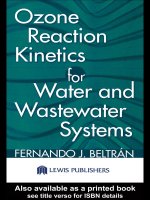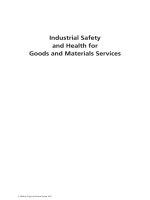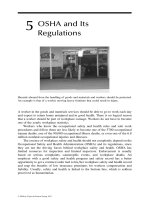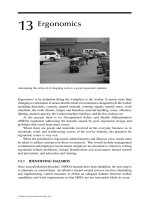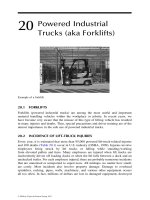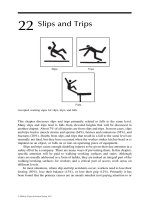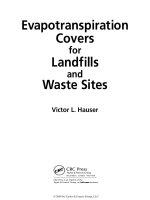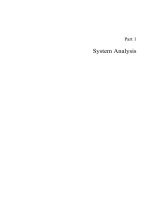Ozone Reaction Kinetics for Water and Wastewater Systems - Chapter 1 pptx
Bạn đang xem bản rút gọn của tài liệu. Xem và tải ngay bản đầy đủ của tài liệu tại đây (2.84 MB, 27 trang )
©2004 CRC Press LLC
©2004 CRC Press LLC
©2004 CRC Press LLC
To my wife, Rosa Maria,
and to my son Fernando
©2004 CRC Press LLC
©2004 CRC Press LLC
Preface
Today, ozone is considered as an alternative oxidant-disinfectant agent with multiple
possibilities of application in water, air pollution, medicine, etc. Particularly, in water
treatment it has many abilities to disinfect, oxidize, or to be combined with other
technologies and reagents. Much of the information about these general aspects of
ozone has been reported in excellent works like that of Langlais et al. (1991). There
is another aspect, however, that the literature has not dealt with sufficiently — the
ozonation kinetics of compounds in water, especially those organic compounds
usually considered water pollutants. About this, on the contrary, there are many
works published in scientific journals like
Ozone Science and Engineering
,
Water
Research
,
Industrial and Engineering Chemistry Research
, etc., that present simple
examples of the multiple possibilities of ozone in water and wastewater treatment
as far as the kinetics is concerned. I thought that this wide array of ozone kinetic
information deserved to be published in a unique book in which the many aspects
of this subject can be grouped together for a better understanding of its fundamentals
through a general overview.
For more than 20 years I have been working on the use of ozone to oxidize
organic compounds, both in organic and, especially, aqueous media. Results of this
research work has generated different doctoral theses on the ozonation of dyes,
phenols, herbicides, polynuclear aromatic hydrocarbons, wastewater, etc, and have
also resulted in more than 100 papers in different scientific journals such as those
cited above. Also, for many years I have been lecturing on ozonation kinetics in
doctoral courses at the University of Extremadura (Badajoz, Spain). As a result of
this accumulated experience, I can affirm that the multiple possibilities of ozone for
application in water and wastewater treatment make the study of the ozonation
kinetics a challenging subject in which theory and practice can be simultaneously
examined. The work presented here represents a compilation of study throughout
my years in this field.
This book is intended for both undergraduate and postgraduate students, teach-
ers, and professionals of water and wastewater treatment. Students who want to get
involve in the world of ozone application in water need to know the many aspects
of the subject covered here, including absorption or solubility of ozone, stability or
decomposition, reactivity, kinetic regime of absorption, ozonation kinetics, and
reactor modeling. Those practicing ozone water treatment, that is, professionals in
the ozonation processes field, will be able to add to their fund of knowledge with
the advanced information it contains. Finally, the book can also be a tool for teaching
in which the many fundamentals of chemistry, reaction mechanisms, and, particu-
larly, chemical engineering kinetics and heterogeneous kinetics can be verified from
examining the results of the ozonation of organic compounds in water.
The various subjects that affect the ozone kinetics in water are presented in 11
chapters. Chapter 1 gives a short history of ozone in nature and tells us about the
electronic structure of the ozone molecule which is responsible for the ozone reactivity.
©2004 CRC Press LLC
In Chapter 2 the chemistry of ozone reactions in water is reviewed by studying the
two known reaction types through which ozone acts in water: the direct and indirect
or free radical reactions. Chapter 3 focuses on the kinetics of the direct ozone reactions.
It is explained that these studies can be developed through experimental homogeneous
and heterogeneous ozone reactions. Chapter 4 and Chapter 5 continue with studies on
direct ozone reaction kinetics, but they exclusively deal with heterogeneous gas–liquid
reaction kinetics which represents the way ozone is applied in water and wastewater
treatment — that is, in gas form. Chapter 4 presents the fundamentals of the kinetics
of these reactions. It gives detailed explanations about the kinetic equations of gas–liq-
uid reactions that are later applied to ozone direct reaction kinetic studies in Chapter
5. Chapter 5 covers examples of kinetic works on ozone gas–water reactions, starting
with the necessary tools to accomplish this task: the properties of ozone in water, such
as solubility and diffusivity. Also in Chapter 5, the ozone kinetic studies are presented
according to the kinetic regimes of ozone absorption that, once established, allow the
rate constant and mass transfer coefficients to be determined. Chapter 6 is dedicated
to wastewater ozonation reactions. Thus, classification of wastewater with regard to
its reactivity with ozone, characterizing parameters, the importance of pH, and the
influence of ozonation on biological processes are treated in Chapter 6. The second
part of Chapter 6 addresses to the kinetics of wastewater ozone reactions and some
insights are given to carry out these studies experimentally.
Chapters 7 to 9 deal with the kinetics of indirect ozone reactions that can also
be named as ozone involving advanced oxidation reactions: ozone alone and ozone
combined with hydrogen peroxide and UV radiation. Chapter 7 deals with the
indirect reactions coming from the decomposition of ozone (without the addition of
hydrogen peroxide or UV radiation). The chapter begins with a study on the relative
importance of ozone direct and the ozone decomposition reactions whose results
are fundamental to establishing the overall kinetics of any ozone–compound B
reaction. Also in Chapter 7, methods to determine the rate constant of the reactions
between the hydroxyl free radical and a compound B, and characteristic relationships
of natural water to ozone reactivity are given. Chapter 8 presents the kinetic study
of ozone–hydrogen peroxide processes. Again, aspects related to the rate constant
determination, kinetic regimes, and competition with direct ozone reactions are
developed. Chapter 9 focuses on the UV radiation/ozone processes. It first deals
with the direct photolytic and UV radiation/hydrogen peroxide processes, the latter
because it is also present when ozone and UV radiation are simultaneously applied.
Chapter 9 includes methods to determine quantum yields, rate constants of hydroxyl
radical reactions, and multiple aspects on the relative importance of different reac-
tions; ozone direct reactions; ozone–peroxide reactions; and ozone direct photolysis,
among other subjects.
Chapter 10 presents the state of the art of another type of ozone action:
heterogeneous catalytic ozonation. Although dating from the 1970s, this field
has advanced significantly in the last decade which has witnessed considerable
increase in work on heterogeneous catalytic ozonation. In Chapter 10, the fun-
damentals of the kinetics of these gas–liquid–solid catalytic reactions are first
given and then applications to the catalytic ozonation of compounds in water.
Also, a commented and extensive list (through tables) of studies already pub-
lished on this ozone action is offered. Finally, Chapter 11 presents the kinetic
modeling of ozone reactions. Chapter 11 starts with a detailed classification on
possible ways of ozone kinetic modeling according to the different kinetic
©2004 CRC Press LLC
regimes of ozone absorption. Mathematical models are presented together with
the way in which they can be solved, with ozone literature examples. The study
focuses on studies of ozone reactions on model compounds, which are more
related to drinking water treatment and wastewater ozonation. The book’s appen-
dix gives mathematical tools, concepts on ideal reactors and actinometry, and
nonideal flow studies needed to solve and understand the ozonation kinetic
examples previously developed.
©2004 CRC Press LLC
About the Author
Fernando Juan Beltran Novillo received his doctorate in chemistry in 1982 from
the University of Extremadura in Badajoz, Spain, and in 1986 he became Profesor
Titular in Chemical Engineering at the University of Extremadura.
In 1985 and 1986 he did postdoctoral studies at the Laboratoire de Chimie de
l’eau et de Nuisances at the University of Poitiers (France) where he worked with
Professors Doré, Legube, and Croué on the ozonation of natural fulvic substances
and the effect on trihalomethane formation. In 1988 and 1989, he worked at the
School of Chemical Engineering, Bath University (England) on catalytic combustion
of PCBs and catalytic wet air oxidation with Professors Kolaczkowski and
Crittenden . He spent another research stay in the Environmental Science and Engi-
neering Department at the University of North Carolina in 1991, working with
Professor Glaze on the UV radiation/hydrogen peroxide oxidation system.
He became Catedratico (Professor) in Chemical Engineering in 1992 at the
University of Extremadura.
In 1993, he was Visiting Professor at the University of Bath (England).
Doctor Beltran has codirected 13 doctoral theses mainly dealing with the ozo-
nation kinetics of model compounds and wastewaters, and has published more than
100 papers on ozonation studies, most of them on kinetics.
He is a member of the International Ozone Association, a member of the editorial
board of
Ozone Science and Engineering
and
International Water Quality
. He has
collaborated in the peer reviewing process of many scientific and engineering jour-
nals such as
Ozone Science and Engineering
,
Industrial
Engineering Chemistry
Research
,
Environmental Science and Technology
,
Water Research
, and
Applied
Catalysis B
.
At present, he teaches chemical reaction engineering for undergraduate students
and ozone reaction kinetics in water for postgraduate students at the University of
Extremadura, where he is also director of a research group on water treatment.
©2004 CRC Press LLC
©2004 CRC Press LLC
©2004 CRC Press LLC
©2004 CRC Press LLC
©2004 CRC Press LLC
©2004 CRC Press LLC
©2004 CRC Press LLC
Contents
Chapter 1
Introduction
1.1 Ozone in Nature
1.2 The Ozone Molecule
References
Chapter 2
Reactions of Ozone in Water
2.1 Oxidation–Reduction Reactions
2.2 Cycloaddition Reactions
2.3 Electrophilic Substitution Reactions
2.4 Nucleophilic Reactions
2.5 Indirect Reactions of Ozone
2.5.1 The Ozone Decomposition Reaction
References
Chapter 3
Kinetics of the Direct Ozone Reactions
3.1 Homogeneous Ozonation Kinetics
3.1.1 Batch Reactor Kinetics
3.1.2 Flow Reactor Kinetics
3.1.3 Influence of pH on Direct Ozone Rate Constants
3.1.4 Determination of the Stoichiometry
3.2 Heterogeneous Kinetics
3.2.1 Determination of the Stoichiometry
References
Chapter 4
Fundamentals of Gas–Liquid Reaction Kinetics
4.1 Physical Absorption
4.1.1 The Film Theory
4.1.2 Surface Renewal Theories
4.2 Chemical Absorption
4.2.1 Film Theory
4.2.1.1 Irreversible First-Order or Pseudo First-Order Reactions
4.2.1.2 Irreversible Second-Order Reactions
4.2.1.3 Series-Parallel Reactions
4.2.2 Danckwerts Surface Renewal Theory
4.2.2.1 First-Order or Pseudo First-Order Reactions
4.2.2.2 Irreversible Second-Order Reactions
4.2.2.3 Series-Parallel Reactions
©2004 CRC Press LLC
4.2.3 Influence of Gas Phase Resistance
4.2.3.1 Slow Kinetic Regime
4.2.3.2 Fast Kinetic Regime
4.2.4 Diffusion and Reaction Times
References
Chapter 5
Kinetic Regimes in Direct Ozonation Reactions
5.1 Determination of Ozone Properties in Water
5.1.1 Diffusivity
5.1.2 Ozone Solubility: The Ozone–Water Equilibrium System
5.2 Kinetic Regimes of the Ozone Decomposition Reaction
5.3 Kinetic Regimes of Direct Ozonation Reactions
5.3.1 Checking Secondary Reactions
5.3.2 Some Common Features of The Kinetic Studies
5.3.2.1 The Ozone Solubility
5.3.2.2 The Individual Liquid Phase Mass-Transfer Coefficient,
k
L
5.3.3 Instantaneous Kinetic Regime
5.3.4 Fast Kinetic Regime
5.3.5 Moderate Kinetic Regime
5.3.5.1 Case of No Dissolved Ozone
5.3.5.2 Case of Pseudo First-Order Reaction with Moderate
Kinetic Regime
5.3.6 Slow Kinetic Regime
5.3.6.1 The Slow Diffusional Kinetic Regime
5.3.6.2 Very Slow Ozone Kinetic Regime
5.4 Changes of the Kinetic Regimes during Direct Ozonation Reactions
5.5 Comparison Between Absorption Theories in Ozonation Reactions
References
Chapter 6
Kinetics of the Ozonation of Wastewaters
6.1 Reactivity of Ozone in Wastewater
6.2 Critical Concentration of Wastewater
6.3 Characterization of Wastewater
6.3.1 The Chemical Oxygen Demand
6.3.2 The Biological Oxygen Demand
6.3.3 Total Organic Carbon
6.3.4 Absorptivity at 254 NM (A254)
6.3.5 Mean Oxidation Number of Carbon
6.4 Importance of pH In Wastewater Ozonation
6.5 Chemical Biological Processes
6.5.1 Biodegradability
6.5.2 Sludge Settling
6.5.3 Sludge Production
6.6 Kinetic Study of the Ozonation of Wastewaters
©2004 CRC Press LLC
6.6.1 Establishment of the Kinetic Regime of the Ozone Absorption
6.6.2 Determination of Ozone Properties for the Ozonation Kinetics
of Wastewater
6.6.3 Determination of Rate Coefficients for the Ozonation Kinetics
of Wastewater
6.6.3.1 Fast Kinetic Regime (High COD)
6.6.3.2 Slow Kinetic Regime (Low COD)
References
Chapter 7
Kinetics of Indirect Reactions of Ozone in Water
7.1 Relative Importance of the Direct Ozone–B Reaction and the Ozone
Decomposition Reaction
7.1.1 Application of Diffusion and Reaction Time Concepts
7.2 Relative Rates of the Oxidation of a Given Compound
7.3 Kinetic Parameters
7.3.1 The Ozone Decomposition Rate Constant
7.3.1.1 Influence of Alkalinity
7.3.2 Determination of the Rate Constant of the OH-B Reaction
7.3.2.1 The Absolute Method
7.3.2.2 The Competitive Method
7.4 Characterization of Natural Waters Regarding Ozone Reactivity
7.4.1 Dissolved Organic Carbon, pH, and Alkalinity
7.4.2 The Oxidation–Competition Value
7.4.3 The R
CT
Concept
References
Chapter 8
Kinetics of the Ozone/Hydrogen Peroxide System
8.1 The Kinetic Regime of the O
3
/H
2
O
2
Process
8.1.1 Slow Kinetic Regime
8.1.2 Fast-Moderate Kinetic Regime
8.1.3 Critical Hydrogen Peroxide Concentration
8.2 Determination of Kinetic Parameters
8.2.1 The Absolute Method
8.2.2 The Competitive Method
8.2.3 The Effect of Natural Substances on the Inhibition of Free
Radical Ozone Decomposition
8.3 The Ozone/Hydrogen Peroxide Oxidation of Volatile Compounds
8.4 The Competition of the Direct Reaction
8.4.1 Comparison Between the Kinetic Regimes of the Ozone–B and
Ozone–Hydrogen Peroxide Reactions
8.4.2 Comparison between the Rates of the Ozone–B and Hydroxyl
Radical–B Reactions
8.4.3 Relative Rates of the Oxidation of a Given Compound
References
©2004 CRC Press LLC
Chapter 9
Kinetics of the Ozone–UV Radiation System
9.1 Kinetics of the UV Radiation for the Removal of Contaminants from
Water
9.1.1 The Molar Absorptivity
9.1.2 The Quantum Yield
9.1.3 Kinetic Equations for the Direct Photolysis Process
9.1.4 Determination of Photolytic Kinetic Parameters: The Quantum
Yield
9.1.4.1 The Absolute Method
9.1.4.2 The Competitive Method
9.1.5 Quantum Yield for Ozone Photolysis
9.1.5.1 The Ozone Quantum Yield in the Gas Phase
9.1.5.2 The Ozone Quantum Yield in Water
9.2 Kinetics of the UV/H
2
O
2
System
9.2.1 Determination of Kinetic Parameters
9.2.1.1 The Absolute Method
9.2.1.2 The Competitive Method
9.2.2 Contribution of the Direct Photolysis and Free Radical
Oxidation in the UV/H
2
O
2
Oxidation System
9.3 Comparison between the Kinetic Regimes of the Ozone-B and
Ozone-UV Photolysis Reactions
9.3.1 Comparison Between the Ozone Direct Photolysis and the
Ozone Direct Reaction With a Compound B through Reaction
and Diffusion Times
9.3.2 Contributions of Direct Photolysis and Direct Ozone Reaction
to the Ozone Absorption Rate
9.3.2.1 Strong UV Absorption Exclusively Due to Dissolved
Ozone
9.3.2.2 Strong UV Absorption due to the Dissolved Ozone
and a Compound B
9.3.2.3 Weak UV Absorption
9.3.3 Contributions of the Direct Ozone and Free Radical Reactions
to the Oxidation of a Given Compound B
9.3.3.1 Strong UV Absorption Exclusively due to Dissolved
Ozone
9.3.3.2 Strong UV Absorption due to Dissolved Ozone and a
Compound B
9.3.3.2 Weak UV Absorption
9.3.4 Estimation of the Relative Importance of the Rates of the Direct
Photolysis/Direct Ozonation and Free Radical Oxidation of a
Compound B
9.3.4.1 Relative Importance of Free Radical Initiation
Reactions in the UV/O
3
Oxidation System
9.3.4.2 Relative Importance of the Direct Reactions and Free
Radical Oxidation Rates of Compound B
References
©2004 CRC Press LLC
Chapter 10
Heterogeneous Catalytic Ozonation
10.1 Fundamentals of Gas–Liquid–Solid Catalytic Reaction Kinetics
10.1.1 Slow Kinetic Regime
10.1.2 Fast Kinetic Regime or External Diffusion Kinetic Regime
10.1.3 Internal Diffusion Kinetic Regime
10.1.4 General Kinetic Equation for Gas–Liquid–Solid Catalytic
Reactions
10.1.5 Criteria for Kinetic Regimes
10.2 Kinetics of the Heterogeneous Catalytic Ozone Decomposition in
Water
10.3 Kinetics of Heterogeneous Catalytic Ozonation of Compounds in
Water
10.3.1 The Slow Kinetic Regime
10.3.2 External Mass Transfer Kinetic Regime
10.3.2.1 Catalyst in Powder Form
10.3.2.2 Catalyst in Pellet Form
10.3.3 Internal Diffusion Kinetic Regime
10.3.3.1 Determination of the Effective Diffusivity and
Tortuosity Factor of the Porous Catalyst
10.3.3.2 Determination of the Rate Constant of the Catalytic
Reaction
10.4 Kinetics of Semiconductor Photocatalytic Processes
10.4.1 Mechanism of TiO
2
Semiconductor Photocatalysis
10.4.2 Langmuir–Hinshelwood Kinetics of Semiconductor
Photocatalysis
10.4.3 Mechanism and Kinetics of Photocatalytic Ozonation
References
Chapter 11
Kinetic Modeling of Ozone Processes
11.1 Case of Slow Kinetic Regime of Ozone Absorption
11.2 Case of Fast Kinetic Regime of Ozone Absorption
11.3 Case of Intermediate or Moderate Kinetic Regime of Ozone
Absorption
11.4 Time Regimes in Ozonation
11.5 Influence of the Type of Water and Gas Flows
11.6 Mathematical Models
11.6.1 Slow Kinetic Regime
11.6.1.1 Both Gas and Water Phases in Perfect Mixing Flow
11.6.1.2 Both Gas and Water Phases in Plug Flow
11.6.1.3 The Water Phase in Perfect Mixing Flow and the Gas
Phase in Plug Flow
11.6.1.4 The Water Phase as N Perfectly Mixed Tanks in Series
and the Gas Phase in Plug Flow
©2004 CRC Press LLC
11.6.1.5 Both the Gas and Water Phases as N and N¢ Perfectly
Mixed Tanks in Series
11.6.1.6 Both the Gas and Water Phases with Axial Dispersion
Flow
11.6.2 Fast Kinetic Regime
11.6.2.1 Both the Water and Gas Phases in Perfect Mixing
11.6.2.2 The Gas Phase in Plug Flow and the Water Phase in
Perfect Mixing Flow
11.6.2.3 Both the Gas and Water Phases in Plug Flow
11.6.3 The Moderate Kinetic Regime: A General Case
11.7 Examples of Kinetic Modeling for Model Compounds
11.8 Kinetic Modeling of Wastewater Ozonation
11.8.1 Case of Slow Kinetic Regime: Wastewater with Low COD
11.8.1.1 Kinetic Modeling of Wastewater Ozonation without
Considering a Free Radical Mechanism
11.8.1.2 Kinetic Modeling of Wastewater Ozonation
Considering a Free Radical Mechanism
11.8.2 Case of Fast Kinetic Regime: Wastewater with High COD
11.8.3 A General Case Of Wastewater Ozonation Kinetic Model
References
Appendixes
Appendix A1 Ideal Reactor Types: Design Equations
A1.1 Perfectly Mixed Reactor
A.1.2 Plug Flow Reactor
Appendix A2 Useful Mathematical Functions
A2.1 Hyperbolic Functions
A2.2 The Error Function
Appendix A3 The Influence of the Type of Flow on Reactor Performance
A3.1 Nonideal Flow Study
A3.1.1 Fundamentals of RTD Function
A3.1.1.1 Determination of the E Function
A3.1.1.2 Moments of the RTD
A3.1.2 RTD Functions of Ideal Flows through the
Reactors
A3.2 Some Fluid Flow Models
A3.2.1 The Perfectly Mixed Tanks in Series Model
A3.2.2 The Axial Dispersion Model
A3.3 Ozone Gas as a Tracer
Appendix A4 Actinometry
A4.1 Determination of Intensity of Incident Radiation
A4.2 Determination of the Effective Path of Radiation
©2004 CRC Press LLC
Appendix A5 Some Useful Numerical Procedures
A.5.1 The Newton-Raphson Method for a Set of Nonlinear
Algebraic Equations
A.5.2 The Runge-Kutta Method for a Set of Non-Linear
First-Order Differential Equations
References
©2004 CRC Press LLC
1
Introduction
At the end of the 1970s, the discovery of trihalomethanes (THM) in drinking water
due to chlorination of natural substances present in the raw water
1,2
gave rise to two
different research lines: the identification of the structures of these natural substances
(i.e., humic substances) and the formation of organochlorine compounds from their
chlorination.
3,4
The search began for alternative oxidant-disinfectants that could play
the role of chlorine without generating the problem of trihalomethane formation.
5,6
This latter research line led to numerous studies on the use of ozone in drinking
water treatment and, therefore, to the study of the kinetics of ozonation reactions in
water. This research line is still productive as recent surveys
7,8
have shown that
organohalogen compounds formed in the treatment of surface waters with chlorine
and other chlorine derived oxidant-disinfectants (i.e., chloramines) yield a greater
number of disinfection by-products than ozone. However, chlorine is not the only
problem affecting water contamination. Other different compounds are often being
discharged in natural waters or in soils where they migrate to reach underground
water. The result is contamination of wells, aquifers, etc. Literature reports under-
ground contamination due to compounds such as volatile aromatics (including benzene,
toluene, xylenes (BTX), methyltertbutylether (MTBE), and volatile organochlori-
nated compounds.
9–12
Ozonation or advanced oxidation processes (AOP) or hydroxyl
radical oxidant based processes, among others, have proven to be efficient technol-
ogies for the removal of these types of pollutants from water.
13–16
However, the application of ozone is not exclusive to the treatment of drinking
water. Ozone also presents numerous applications to the treatment of wastewater.
Here, chlorine is mainly used for disinfection purposes, leading to many problems
in the aquatic environment where treated wastewater is released.
17
Thus, organochlo-
rine compounds generated from wastewater chlorination can harm aquatic organisms
in receiving waters. The U.S. Environmental Protection Agency (USEPA) has estab-
lished a limit of less than 11
µ
g/l for total residual chlorine in fresh waters
18
which
is usually surpassed when chlorinated wastewater is discharged.
19
Thus, wastewater
treatment plant operators often face balancing two contradictory aspects: the use of
chlorine for wastewater disinfection and the preservation of aquatic life. Thus,
alternative oxidant-disinfectant agents are needed for wastewater treatment. As
shown in Chapter 6, ozone has been used in the treatment of a variety of wastewater.
It should be highlighted, however, that ozone, like other oxidants, also produces by-
products such as bromate (in water containing bromide) that can be harmful.
20
The
USEPA promulgated the Stage 1 Disinfectants/Disinfection By-Products (D/DBP)
Rule to regulate the MCL of bromate (10
µ
g/l), chlorite (1 mg/l), THMs (80
µ
g/l),
and haloacetic acids (10
µ
g/l).
21
This rule took effect on January 1, 2002 but EPA
©2004 CRC Press LLC
plans to reexamine the bromate MCL in its 6-year review process.
22
So, when using
ozone in the treatment of water some caution must be taken to avoid or diminish
DBPs as much as possible.
Contrary to what might be assumed from this history, the use of ozone in the
treatment of drinking water was not new when THMs were discovered in chlorinated
drinking water. In fact, ozone started to be used, mainly as a disinfectant, at the end
of the 19th century in many water treatment plants in Europe.
23
The fact that chlorine
was the main oxidant-disinfectant agent was due, among other reasons, to both
extensive studies on its use during World War I for chemical weapons and, of course,
due to its cost.
Today, however, there are numerous water treatment plants, mainly for drinking
water, that include some ozonation step in their treatment lines. In addition, interest in
the kinetics of these processes has been growing due to their double practical–academic
aspects. Thus, since ozonation of compounds in water is a gas–liquid heterogeneous
reaction, the process is of high academic interest because, outside the chemical
industry, it is one of the few practical cases where different chemical reaction
engineering concepts (mass transfer, chemical kinetics, reactor design, etc.) apply.
On the other hand, data on ozonation and related processes (i.e., advanced
oxidation processes) are of practical interest in addressing the design of ozone
reactors or contact times to achieve a given reduction of pollution from water,
improvement of wastewater biodegradability during conventional biological oxida-
tion, or increased settling rate in sedimentation, etc.
Ozone applications in the treatment of water and wastewater can be classified
into three categories: disinfectants or biocides, classical oxidants to remove organic
pollutants, and pre or posttreatment agents to aid in other unit operations (coagula-
tion, flocculation, sedimentation, biological oxidation, carbon adsorption, etc.).
24–28
1.1 OZONE IN NATURE
In 1785, the odor released from the electric discharges of storms led Van Mauren,
a Netherlands chemist, to suspect the presence of a new compound. Later, in 1840,
Schonbein finally discovered ozone although its chemical structure as a triatomic
oxygen molecule was not confirmed until 1872
23
and much later was established as
a hydride resonance structure in 1952.
29
Ozone is formed in a natural way in the upper zones of the atmosphere (about
25 km above sea level and a few kilometers wide) where it surrounds earth and
protects the surface of the planet from UV-B and UV-C radiation. The spontaneous
generation of ozone is due to the combination between bimolecular and atomic
oxygen, a reaction that starts to develop from, approximately, 70 km high above sea
level down to about 20 km from earth surface where unfavorable conditions are
established. In the atmosphere closed to the earth’s surface, however, ozone is a
toxic compound with a maximum contaminant level of 0.1 ppm for expositions of
at least 8 h.
30
From the positive point of view, the properties of ozone, derived from
its reactivity, have been applied in the treatment of water in medicine, organic
chemical synthesis, etc.
©2004 CRC Press LLC
1.2 THE OZONE MOLECULE
The ozone reactivity is due to the structure of the molecule. The molecule of ozone is
constituted by three oxygen atoms. The atom of oxygen has the following electronic
configuration surrounding the nuclei:
1s
2
2s
2
2p
x
2
2p
y
1
2p
z
1
, i.e., in its
valence band
it has two unpaired electrons, each one occupying one
2p
orbital. In order to combine
three oxygen atoms and yield the ozone molecule, the central oxygen rearranges in
a plane
sp
2
hybridation from the
2s
and two
2p
atomic orbitals of the
valence band
.
With this rearrangement the three new
sp
2
hybrid orbitals form an equilateral triangle
with an oxygen nuclei in its center, i.e., with an angle of 120º between the orbitals.
However, in the ozone molecule this angle is 116º 49
′
.
29
The other
2p
orbital of
the
valence band
keeps perpendicular to the
sp
2
plane as Figure 1.1 shows, with two
coupled electrons. Two of the
sp
2
orbitals from the central oxygen, forming the angle
above indicated bond with one
2p
orbital (each containing one electron) of the other
two adjacent oxygen atoms in the ozone molecule, while the third
sp
2
orbital has a
couple of nonshared electrons. Finally, the third
2p
orbital of each adjacent atomic
oxygen that has only one electron combines with the
2p
2
orbital remaining of the
central oxygen to yield two
π
molecular orbitals that move throughout the ozone
molecule. As a consequence, the ozone molecule presents a hybrid formed by the
four possible structures shown in Figure 1.2. The length of the bond between
FIGURE 1.1
The molecular structure of ozone.
FIGURE 1.2
Resonance forms of the ozone molecule.
σ Bond
Π Bond
116° 49
'
2P Orbital
Oxygen atom
sp
2
Orbital
III III IV
©2004 CRC Press LLC
oxygen atoms in the ozone molecule has been experimentally found to be 1.278 Å,
which is an intermediate value between the length of an oxygen double bond (1.21
Å) and that of a simple oxygen–hydrogen bond in the hydrogen peroxide molecule
(1.47 Å). According to literature
29
the calculated lengths show that the bond between
oxygen atoms in the ozone molecule has a 50% likelihood as a double bond.
Therefore, the resonance structures I and II in Figure 1.2 basically represent the
electronic structure of ozone. Nonetheless, resonance forms III and IV also contribute
to some extent to the ozone molecule because the ozone angle is something lower
than 120º due to the attraction of adjacent oxygen atoms, positively and negatively
charged.
The resonance forms of the ozone molecule confer some sort of polarity. Dif-
ferent properties of molecules (solubility, type of reactivity of bonds, etc.) are
partially due to the polarity which is measured with the dipolar momentum. The
ozone molecule presents a weak polarity (0.53 D), probably due to the electroneg-
ativity of oxygen atoms and the unshared pairs of electrons in some of the orbitals
that contribute to the total dipolar momentum in opposing directions.
The high reactivity of ozone can then be attributed to the electronic configuration
of the molecule. Thus, the absence of electrons in one of the terminal oxygen atoms
in some of the resonance structures confirms the electrophilic character of ozone.
On the contrary, the excess of negative charge present in some other oxygen atom
imparts a nucleophilic character. These properties makes ozone an extremely reactive
compound. Table 1.1 presents some physico–chemical properties of ozone.
TABLE 1.1
Physical-Chemical Properties of Ozone
Property Value
Melting point, ºC –251
Boiling point, ºC –112
Critical pressure, atm 54.62
Critical temperature, ºC –12.1
Specific gravity 1.658 higher than air
1.71 gcm
–3
at –183ºC
Critical density, kgm
–3
436
Heat of vaporization, calmol
–1 a
2,980
Heat of formation, calmol
–1 b
33,880
Free energy of formation, calmol
–1 b
38,860
Oxidation potential, V
c
2.07
a
At the boiling point temperature.
b
At 1 atm and 25ºC.
c
At pH = 0.
Source:
Perry, R.H. and Green, D.W.,
Perry’s Chemical Engineers
Handbook
, 7th ed., McGraw-Hill, New York, 1997. With permission.
